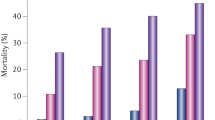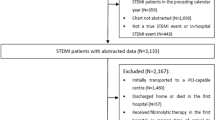Abstract
Emergency department and hospital crowding have become an increasing problem. The clinical outcomes of prolonged emergency department (ED) length of stay in acute ST-segment elevation myocardial infarction (STEMI) patients after reperfusion are still unknown. Between January 2008 and December 2011, 432 consecutive patients with STEMI undergoing primary PCI were recruited. Patients were divided into two groups: the immediate admission group (length of ED stay <8 h; IA group) and the prolonged ED stay group (length of ED stay ≧8 h; PS group). The median lengths of ED stay of the patients in both groups were 29.97 h in the PS group (n = 145, 33.6 %) and 1.78 h in the IA group (n = 287, 66.4 %), respectively. The age, gender, risk factors of coronary artery disease, characteristic of coronary angiography, and TIMI risk score did not differ between the two groups. During nearly 4-year clinical follow-up, the short-term and long-term clinical outcomes were similar between the two groups. B-blocker and statins were used infrequently in the ED. In addition, patients with high TIMI risk score in the PS group had higher incidence of 1-year re-MI (6.8 vs. 1.8 %; p = 0.045). In the era of primary PCI for STEMI patients after reperfusion, prolonged ED length of stay may not influence clinical outcomes. Patients with high TIMI risk score in the PS group still had a trend toward worse clinical outcome after long ED stays.

Similar content being viewed by others
References
Lozano R, Naghavi M, Foreman K et al (2012) Global and regional mortality from 235 causes of death for 20 age groups in 1990 and 2010: a systematic analysis for the global burden of disease study 2010. Lancet 380:2095–2128
O’Gara PT, Kushner FG, Ascheim DD et al (2013) 2013 ACCF/AHA guideline for the management of ST-elevation myocardial infarction: a report of the American college of cardiology foundation/American heart association task force on practice guidelines. Circulation 127:e362–e425
Steg PG, James SK, Atar D et al (2012) ESC Guidelines for the management of acute myocardial infarction in patients presenting with ST-segment elevation. Eur Heart J 33:2569–2619
Stevenson WG, Linssen GC, Havenith MG et al (1989) The spectrum of death after myocardial infarction: a necropsy study. Am Heart J 118:1182–1188
Pines JM, Hilton JA, Weber EJ et al (2011) International perspectives on emergency department crowding. Acad Emerg Med 18:1358–1370
Chalfin DB, Trzeciak S, Likourezos A et al (2007) DELAY-ED study group. Impact of delayed transfer of critically ill patients from the emergency department to the intensive care unit. Crit Care Med 35:1477–1483
Guttmann A, Schull MJ, Vermeulen MJ et al (2011) Association between waiting times and short term mortality and hospital admission after departure from emergency department: population based cohort study from Ontario, Canada. BMJ 342:d2983
Diercks DB, Roe MT, Chen AY et al (2007) Prolonged emergency department stays of non-ST-segment-elevation myocardial infarction patients are associated with worse adherence to the American college of cardiology/American heart association guidelines for management and increased adverse events. Ann Emerg Med 50:489–496
Liew D, Liew D, Kennedy MP (2003) Emergency department length of stay independently predicts excess inpatient length of stay. Med J Aust 179:524–526
Yip HK, Chen MC, Chang HW et al (2002) Angiographic morphologic features of infarct-related arteries and timely reperfusion in acute myocardial infarction: predictors of slow-flow and no-reflow phenomenon. Chest 122:1322–1332
Yip HK, Wu CJ, Chang HW et al (2003) Effect of the PercuSurge GuardWire device on the integrity of microvasculature and clinical outcomes during primary transradial coronary intervention in acute myocardial infarction. Am J Cardiol 92:1331–1335
Yip HK, Wu CJ, Chang HW et al (2001) Comparison of impact of primary percutaneous transluminal coronary angioplasty and primary stenting on short-term mortality in patients with cardiogenic shock and evaluation of prognostic determinants. Am J Cardiol 87:1184–1188
Bernstein SL, Aronsky D, Duseja R et al (2009) The effect of emergency department crowding on clinically oriented outcomes. Acad Emerg Med 16:1–10
Morrow DA, Antman EM, Charlesworth A et al (2000) TIMI risk score for ST-elevation myocardial infarction: a convenient, bedside, clinical score for risk assessment at presentation: An intravenous nPA for treatment of infarcting myocardium early II trial substudy. Circulation 102(17):2031–2037
Tsai CL, Magid DJ, Sullivan AF et al (2010) Quality of care for acute myocardial infarction in 58 U.S. emergency departments. Acad Emerg Med 17:940–950
Keeley EC, Boura JA, Grines CL (2003) Primary angioplasty versus intravenous thrombolytic therapy for acute myocardial infarction: a quantitative review of 23 randomised trials. Lancet 361:13–20
Nasi LA, Ferreira-Da-Silva AL, Martins SC et al (2014) Implementation of a dedicated cardiovascular and stroke unit in a crowded emergency department of a tertiary public hospital in Brazil: effect on mortality rates. Acad Emerg Med 21:40–46
Jones DA, Rathod KS, Howard JP et al (2012) Safety and feasibility of hospital discharge 2 days following primary percutaneous intervention for ST-segment elevation myocardial infarction. Heart 98:1722–1727
Noman A, Zaman AG, Schechter C et al (2013) Early discharge after primary percutaneous coronary intervention for ST-elevation myocardial infarction. Eur Heart J Acute Cardiovasc Care 2:262–269
Tsai TH, Chua S, Hussein H et al (2011) Outcomes of patients with Killip class III acute myocardial infarction after primary percutaneous coronary intervention. Crit Care Med 39:436–442
Author information
Authors and Affiliations
Corresponding authors
Ethics declarations
Conflict of interest
The authors declare that there is no conflict of interest.
Funding
This research received no grant from any funding agency in the public, commercial, or not-for-profit sectors.
Statement of human and animal rights
All procedures followed were in accordance with the ethical standards of the responsible committee on human experimentation (institutional and national) and with the Helsinki Declaration of 1964 and later revisions.
Informed consent
Informed consent was obtained from all patients for being included in the study.
Additional information
W.-C. Lee contributed equally as first author.
Rights and permissions
About this article
Cite this article
Chen, HC., Lee, WC., Chen, YL. et al. The impacts of prolonged emergency department length of stay on clinical outcomes of patients with ST-segment elevation myocardial infarction after reperfusion. Intern Emerg Med 11, 107–114 (2016). https://doi.org/10.1007/s11739-015-1330-5
Received:
Accepted:
Published:
Issue Date:
DOI: https://doi.org/10.1007/s11739-015-1330-5




